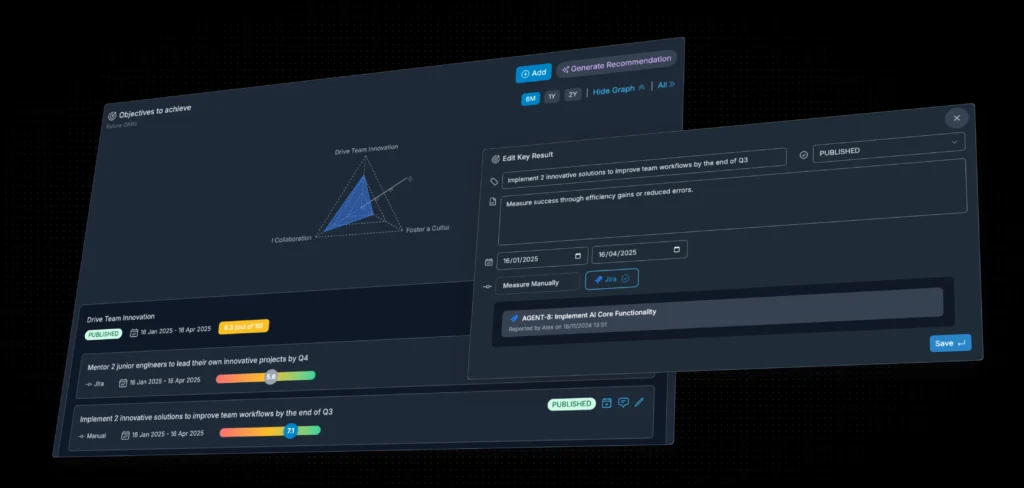Why key results matter
Imagine setting an objective like: “Be the industry leader in innovation.” Sounds inspiring, right? But here’s the problem: how do you measure that? Is it about patents filed? Revenue growth? Or the number of times your CEO gets quoted saying “disruptive”?
This is where key results step in. They take lofty objectives and turn them into specific, measurable outcomes. Key results ensure your team knows:
- What success actually looks like.
- How progress is tracked.
- What everyone’s role is in making it happen.
Without key results, an objective is just a motivational poster—nice to look at, but not particularly actionable.
Objectives vs. key results: Know the difference
If objectives are your destination, key results are the GPS coordinates that get you there. Here’s how they differ:
- Objectives are broad, qualitative, and aspirational.
- Example: “Deliver an exceptional user experience.”
- Key results are specific, measurable, and quantitative.
- Example: “Increase app store rating from 4.2 to 4.6 stars.”
Without key results, objectives are vague and open to interpretation. With them, you have a clear path forward—and fewer chances for your team to play “guess what the boss meant.”
Key results in action: an example we can all relate to
Let’s say your team’s objective is to improve platform reliability. Instead of leaving it as an inspiring-but-fuzzy statement, you could define key results like:
- Reduce downtime from 2% to under 0.5%.
- Decrease critical incident response times from 20 minutes to 10 minutes.
- Achieve 100% automation in system health monitoring.
Notice how these key results are precise, measurable, and tied to outcomes? That’s the power of KRs—they give your team something tangible to aim for, not just a vague sense of “let’s do better.”

Why success isn’t about hitting 100%
Here’s the secret sauce of key results: they’re not about perfection. In fact, if you’re hitting 100% of your KRs every time, you’re probably not challenging yourself enough.
The sweet spot is 70-80% completion, and here’s why:
- 70% means you stretched. It shows you set ambitious targets and made meaningful progress.
- 100% might mean it was too easy. And where’s the fun in that?
This approach creates a culture of growth and innovation, where teams are encouraged to aim high without fearing “failure.” After all, sometimes the biggest wins come from the stretch, not the finish line.

Automating key result tracking: less hassle, more progress
If tracking KRs manually sounds about as fun as debugging someone else’s code, you’re not alone. That’s why automation is a game-changer.
Here’s how tools like ClarityLoop can help:
- Real-time updates: Link KRs to live data sources like project tools or performance metrics, so progress updates itself.
- Fewer emails, more action: No more chasing teammates for numbers or updates—let the system do the heavy lifting.
- Clear dashboards: Visualize progress, spot blockers, and make adjustments quickly.
For example, if one of your KRs is “Reduce onboarding time from 10 days to 7 days,” automated tools can pull data directly from your HR system, showing real-time progress without you lifting a finger.
How key results align and inspire teams
Key results don’t just measure outcomes—they shape how teams work together. Here’s what happens when they’re done well:
- Clarity: Everyone knows what’s expected and how success is defined.
- Accountability: Transparency into KRs ensures shared ownership across the team.
- Motivation: Teams can see progress in real-time, keeping momentum high.
When KRs are baked into daily workflows, they’re not just checkboxes—they’re the compass that keeps your team pointed in the right direction.
Why key results are more than metrics
The brilliance of key results lies in their ability to take big ideas and make them actionable. They break down ambitious objectives into steps that are clear, measurable, and motivating, ensuring teams aren’t just busy—they’re effective.
With automation reducing the friction of tracking and updating, KRs become less about admin and more about impact. Because at the end of the day, success isn’t about perfection—it’s about progress, alignment, and moving the needle in meaningful ways.


